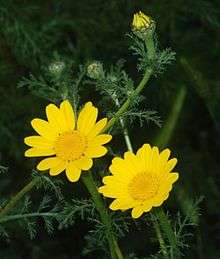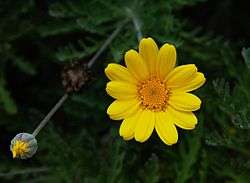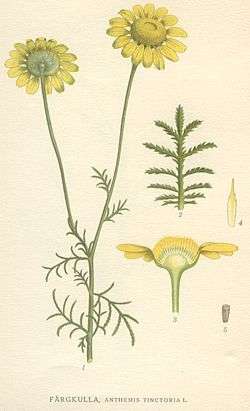Cota tinctoria
| Cota tinctoria | |
|---|---|
 | |
| Yellow Camomille (Cota tinctoria) | |
| Scientific classification | |
| Kingdom: | Plantae |
| (unranked): | Angiosperms |
| (unranked): | Eudicots |
| (unranked): | Asterids |
| Order: | Asterales |
| Family: | Asteraceae |
| Genus: | Cota |
| Species: | C. tinctoria |
| Binomial name | |
| Cota tinctoria (L.) J. Gay ex Guss. [1] | |
| Synonyms | |
|
Synonymy
| |

Cota tinctoria (golden marguerite, yellow chamomile, oxeye chamomile), is a species of perennial flowering plant in the sunflower family. Other common names include "dyer's chamomile", "Boston daisy", "Paris daisy". In horticulture this plant is still widely referred to by its synonym Anthemis tinctoria.[2]
It is a short-lived plant often treated as biennial, native to Europe, the Mediterranean and Western Asia and naturalized in scattered locations in North America.[3][4] It has aromatic, bright green, feathery foliage. The serrate leaves are bi-pinnatifid (= finely divided) and downy beneath. It grows to a height of 60 cm.[5]
It has yellow daisy-like terminal flower heads on long thin angular stems, blooming in profusion during the summer.[5]
It has no culinary or commercial uses and only limited medicinal uses. However, it produces excellent yellow, buff and golden-orange dyes, used in the past for fabrics.[6]
Cota tinctoria is grown in gardens for its bright attractive flowers and fine lacy foliage; there is a white-flowering form also but the most commonly grown form is the seed raised cultivar 'Kelwayi' which has 5 cm wide, yellow flowers on 65 cm plants. The asexually propagated cultivar 'E.C. Buxton' is a hybrid between this species and another Anthemis species.
- Subspecies
- Cota tinctoria subsp. australis (R.Fern.) Oberpr. & Greuter
- Cota tinctoria subsp. euxina (Boiss.) Oberpr. & Greuter
- Cota tinctoria subsp. fussii (Griseb. & Schenk) Oberpr. & Greuter
- Cota tinctoria subsp. gaudium-solis (Velen.) Oberpr. & Greuter
- Cota tinctoria subsp. parnassica (Boiss. & Heldr.) Oberpr. & Greuter
- Cota tinctoria subsp. sancti-johannis (Stoj. & al.) Oberpr. & Greuter
- Cota tinctoria subsp. virescens (Bornm.) Oberpr. & Greuter

References
- ↑ Florae Siculae Synopsis 2: 866. 1844 [1845].
- ↑ RHS A-Z encyclopedia of garden plants. United Kingdom: Dorling Kindersley. 2008. p. 1136. ISBN 1405332964.
- ↑ Altervista Flora Italiana, Camomilla dei tintori, Färberkamille, Cota tinctoria (L.) J. Gay includes many photos plus European distribution map
- ↑ Biota of North America Program 2014 county distribution map
- 1 2 Flora of North America, Golden marguerite, yellow chamomile, Cota tinctoria (Linnaeus) J. Gay ex Gussone, Fl. Sicul. Syn. 2: 867. 1845.
- ↑ Euro+Med PlantBase - the information resource for Euro-Mediterranean plant diversity
| Wikimedia Commons has media related to Cota tinctoria. |